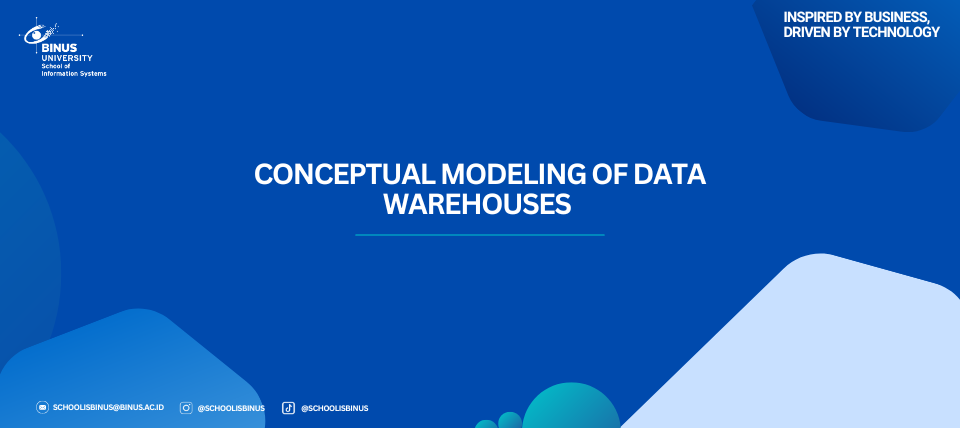Conceptual Modeling of Data Warehouses

Introduction
Conceptual modeling is the foundational stage in data warehouse (DW) design, where business requirements are transformed into high-level representations of data and their relationships. Unlike logical or physical models, conceptual models are independent of technical constraints and focus primarily on what data is needed and how it should be understood from a business perspective. According to Bhatia (2019), conceptual modeling provides a semantic layer that bridges business processes with analytical data structures, ensuring that decision-making systems are aligned with organizational goals.
Objectives and Importance
The main objective of conceptual modeling is to capture the essence of an organization’s analytical needs before defining how data will be stored or accessed. It identifies business processes, measures, and analytical perspectives while avoiding technical details such as schema normalization or indexing (Bhatia, 2019). Conceptual models enable clear communication between business users and system designers, helping to prevent misunderstandings in later design stages.
Recent studies emphasize that an effective conceptual model improves data integration, supports scalability, and reduces redundancy in subsequent DW layers (Dhaouadi et al., 2022). In big data environments, conceptual modeling also plays a crucial role in defining integration points among heterogeneous sources.
Modeling Approaches and Techniques
Bhatia (2019) describes several conceptual modeling techniques tailored to data warehouse environments:
- Entity-Relationship (ER) Model: A classic approach that identifies entities, attributes, and relationships. While effective for transactional systems, it is often extended to represent analytical requirements.
- Multidimensional (MD) Model: A more business-oriented approach where data is viewed in terms of facts and dimensions. Facts represent quantitative measures (e.g., sales, profit), while dimensions define analytical perspectives (e.g., time, location, product).
- StarER and UML-based Models: Modern conceptual models combine the clarity of ER diagrams with multidimensional semantics. Tools like Unified Modeling Language (UML) help formalize hierarchies, constraints, and business rules that are essential for later logical modeling.
Furthermore, conceptual frameworks such as ontology-based models and data vault conceptual maps are emerging to handle semantic interoperability and metadata management in data lake and hybrid architectures (Bimonte et al., 2023).
Conceptual Design Process
The conceptual modeling process typically involves the following steps (Bhatia, 2019; Helskyaho et al., 2024):
- Business Requirement Analysis : Identify strategic goals, decision-support needs, and key performance indicators (KPIs).
- Process Identification : Determine major business processes and their measurable outcomes.
- Fact and Dimension Definition : Define facts (quantitative measures) and dimensions (contextual attributes).
- Hierarchy and Relationship Mapping : Model aggregation levels and relationships between dimensions.
- Validation and Refinement : Review the model with stakeholders to ensure semantic consistency and completeness.
Dhaouadi et al. (2022) highlight that iterative validation with stakeholders is essential to ensure that conceptual models remain business-driven and adaptable to changes.
Conclusion
Conceptual modeling is the cornerstone of data warehouse development. It translates complex business goals into structured, understandable representations of information needs. Bhatia (2019) emphasizes that a well-constructed conceptual model sets the direction for logical and physical design, ensuring that the data warehouse aligns with organizational strategy and analytical objectives. Recent advancements such as ontology-based modeling, quality metrics, and multi-model integration extend the role of conceptual modeling beyond traditional data warehousing, making it essential in the era of big data and hybrid analytics.
References
Bhatia, P. (2019). Data Mining and Data Warehousing: Principles and Practical Techniques. Cambridge University Press.
Bimonte, S., Gallinucci, E., Marcel, P., & Rizzi, S. (2023). Logical design of multi-model data warehouses. Knowledge and Information Systems, 65, 1067–1103. https://doi.org/10.1007/s10115-022-01788-0
Dhaouadi, A., Bousselmi, K., Gammoudi, M. M., Monnet, S., & Hammoudi, S. (2022). Data warehousing process modeling from classical approaches to new trends: Main features and comparisons. Data, 7(8), 113. https://doi.org/10.3390/data7080113
Helskyaho, H., Ruotsalainen, L., & Männistö, T. (2024). Defining data model quality metrics for Data Vault 2.0 model evaluation. Inventions, 9(1), 21. https://doi.org/10.3390/inventions9010021

